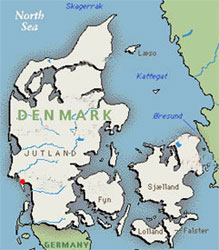Esbjerg, Denmark
 |
|
Esbjerg is a harbour city in Denmark which is often overlooked by tourists. The town is generally only visited by tourists who are staying in the many Danish summer homes in the area or by tourists who are making use of the Esberg Airport (Esbjerg Lufthavn). However, the town and the surrounding areas do have a number of interesting attractions worth visiting.
Esbjerg’s has the largest fishery harbour in all of Denmark, and visitors can’t help but notice the extremely overpowering smell of fish in the harbour area. The fishing industry is very important to Esbjerg’s economy. In fact, people from Esbjerg say that, “Esbjerg doesn’t smell like fish, it smells like money”. Fortunately for those who are not accustomed to the strong smell of money the smell is generally localized around the harbour.
The older section of the city has many impressive buildings from the beginning of the industrialization of the city around the 1900. Esbjerg has an excellent Fishing and Seafaring Museum (Fiskeri- og Søfartsmuseet) which has a superb aquarium. The museum is a great place for children. Close to the museum is the famous ”Men at Sea”(Mennesket ved Havet) outdoor sculpture which is a very imposing sculpture of four men looking out to see.
The city is also the home of the oldest lightship or lightvessel in the world. Lightships were essentially ships that act as a lighthouse. They were used in areas where the building of a lighthouse was unsuitable because the water was too deep or the ground was too unstable. At the Lightship Museum (Museumsfyrskib) you may board the 1912 lightship too see what living conditions were like on board.
Increasingly Esbjerg has been used as a home base for tourists who wish to enjoy the many natural wonders in the surrounding area. Considering that Southwest Denmark has a rather unique environment and it is a very popular tourist area in the summertime this is hardly surprising. The Esbjeg area has some of the best beaches in Denmark. The area has countless beaches, water activities, boat tours, boat rentals, cottages and camping. Also, southwest Denmark is known to have some of the finest river and stream fishing in Western Europe.It is also an excellent area for bike trips.
A short 12 minute ferry ride from Esbjerg is the extremely popular island of Fano (Fanø). The 16 km long and 5 km wide island is an excellent place to visit. This small island is a mecca for tourists and it is a great place to spend the day. The island has excellent beaches, bike paths, nature walks and a number of good places to eat. The island also has a number of bunkers from World War II. The island is famous for its remarkable tide. When the tide is out you can litterally walk kilometers out from the shoreline before reaching the water.
An oddly popular attraction is the Esbjerg fish auction. The fish auction is for tourists and you are welcome to come and bid on the catch of the day. The fish auction is held every Wednesday from mid-July to mid-August.
History:
The history of Esbjerg is relatively short. In 1864, Denmark lost control of Altona which was its most important west coast harbour city. Altona was transfer to German control after the Second War of Schleswig. While the port city was only under Danish control from 1840-1864 the port had become very important to the Danish economy. During this period trade of farming products with England had grown significantly.
Rather than attempting to reclaim the city of Altona and thus face another war with the emerging country of Germany the Danish Monarchy made a bold move, and the decision was made to build a new harbour. The harbour was built in the area we know today as Esbjerg, but at the time Esbjerg was little more than a collection of farms.
Esbjerg was officially founded in 1868. The harbour opened for business in 1874, and in the same year a railroad was completed linking Esbjerg with the important town of Fredericia on the east coast of Jutland (Jylland).
The town received royal borough privileges in 1899, and the cities population grew very quickly as Esbjerg became more and more powerful economically.
From the beginning building and further expansions of Esbjerg have been carefully planned. The result is that today a map of the older parts of town resembles a chessboard with straight and wide streets.
The harbour which is vital to Esbjerg’s economy has ferry connections to England and it is the biggest fishery harbour in Denmark. In recent years Esbjerg has become the headquarters for the Denmark’s important offshore oil and gas industry in the North Sea.
Recently Esbjerg has become an important education centre in Denmark. Esbjerg has campuses for both the University of Southern Denmark (Syddansk Universitet) which opened in 1998 and Aalborg University (Aalborg Universitet) which opened in 1995.
In 1997 and 2006 Esbjerg was voted the “City of the Year” in Denmark.
Esbjerg - Things to See and Do (Part 1)
Esbjerg - Things to See and Do (Part 2)
LastUpdate: 2019-06-28 21:17:52
